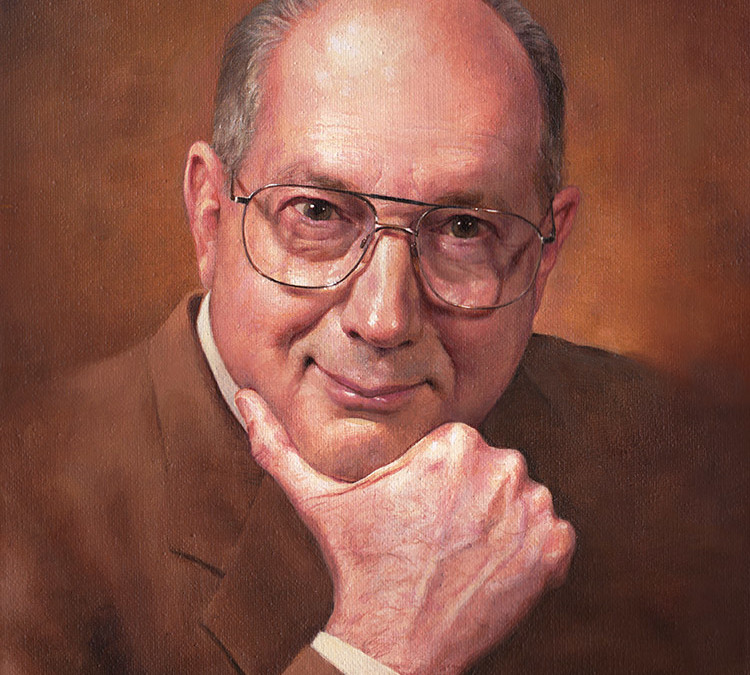
by Matt Philleo | Sep 23, 2015 | How to Paint Instruction, My Art in Progress, New Artwork, Tips for Artists
I have been doing commissioned portraits for 24 years, since I was in high school. One of the questions I’m often asked is: “How do you create your art?”
I am going to show you a recent portrait I did, step by step, and my hope is that you may be able to learn a few tips that will help you in your own portrait painting. Although I paint in acrylic, some of this information may help you even if you paint in oils. If you are not a painter, I hope this post will still be interesting to you! Who knows? You could even start painting today! For this particular example, my portrait was based off a great photo (which unfortunately I am unable to show since it was a professional photograph ) and it lent itself to a great painted portrait. Amateur snapshots can be used as a basis for a portrait, but unfortunately, the lighting and detail is usually lacking, so the image you create from them as an artist is similarly lacking in depth. Get the best photo you can, and your painting will be all the better for it. Step 1: Start Right With a SketchWithout a good sketch, you’re just shooting in the dark. The sketch is where you will create your composition, ensure the likeness of your subject–that is, make sure the person you’re painting looks like them–and define specific details.Be sure to center your subject on the surface of the canvas and if it is a head and shoulders portrait, the face should fill about 1/3-1/2 of the height of the canvas. Pay attention to the eyes and special details that make a person unique. Draw exactly what you see, not what you think you see. In the future, I plan on doing a lesson covering just the sketching/drawing aspect of portraiture, and there we will go more in depth on the process. Many artists find it difficult to sketch on canvas with a pencil. I do as well. Once pencil gets embedded in the canvas texture, it is extremely difficult to erase. You may be able to get away with a very light pencil (3H or lighter) but even then, you will still find it difficult to erase if you use a lot of pencil strokes like I do.

How to Paint Acrylic Portraits Step 1
And for every good pencil stroke I put down, I probably put down about 4 bad ones. I love erasers. I think there is an analogy about life in here somewhere, but I’m sure you can make the correlation yourself! Here is a trick I learned: I use a pastel or charcoal pencil instead. Pastel pencil erases with ease, but you will need a very good sharpener to keep it sharp and not break the lead in the process. Sometimes I use a knife if the sharpener doesn’t do the trick. Another great thing about pastel pencil is that you can use a sepia tone and it will blend in better with the flesh color of your paint. Graphite pencil sticks out like a sore thumb and you have to really work to conceal it in your painting. Because pastel pencil can almost be brushed off the surface of the canvas, it will be necessary to “seal in the sketch” so that you do not disturb or erase it as you paint. I use clear acrylic medium (Matte medium) thinned down with water of a ratio about 80% water/ 20% medium and put this solution in an empty hairspray bottle. Then I lightly mist the solution onto the surface of the canvas. If you find it starting to bead up heavily and dripping, take a cotton towel and gently blot the excess moisture off. Don’t worry–you will not ruin your sketch if you blot it.Let the canvas dry. In the meantime, dump out the excess solution into a separate container, and rinse out your spray bottle by filling it with straight water and spraying it several times to clear the solution out. If you don’t do this, you will need to find another spray bottle for your next painting because the nozzle will be clogged. After your canvas is completely dry, brush over the entire surface with matte medium to completely seal in the sketch. You will find that the pastel pencil sketch is not disturbed because you’ve already partially sealed it in already with the spray.
Take my FREE Acrylic Portrait Painting Challenge!

Learn how to paint a realistic acrylic portrait in my 2022 Spring Portrait Painting Challenge! Even if you’re a beginner. It’s free to join and I’ll teach you how to do it with online, step-by-step video lessons.
In May 2022, several artists like you will all be painting a portrait from the same photo reference. This will be a great chance to learn and create something amazing.
Take the Acrylic Portrait Painting Challenge (it’s free to enter)…and I’ll send you a welcome kit, which includes:
- My Complete Supplies List you will need to paint along (paint, mediums, brushes, canvas, etc.)
- A Palette Guide on how to set up your colors for easy paint mixing.
- The Reference Photo With Grid (coming soon.) It will help you create an accurate, frustration-free sketch!
- Step-by-Step Demonstration Videos on how to paint the portrait successfully, sent right to your inbox.
- Access to my private Facebook Group where you can post your progress, get feedback and be encouraged.
Click the link below to register for my Acrylic Portrait Painting Challenge and get started…
And now back to our tutorial…
Step 2: Define Your Values. Of course, you know I’m not talking about family values, company ethics or anything like that. (Although those don’t hurt either!) Values are areas of light and dark in artwork, and how they relate to each other. To begin the painting process, I like to take a glaze, a mixture of burnt umber, raw sienna and white, thinned to about 70% translucency with matte medium and then paint that over the entire sketch. What this does is mute the sketch a little bit, so the contrast is not so harsh. And that makes the paint blend in a lot better. Let this dry. Next, use a slightly darker glaze and fill in the darker areas, such as clothing, the background, especially if it will be darker than the value of the face. Brush it out as smoothly as possible. What we want to do is quickly establish the tonal values of the painting and define the contours of the face, hand and clothing. In realistic paintings, we do not use a line to define an person or object from the background, but rather, we separate them by value and color.
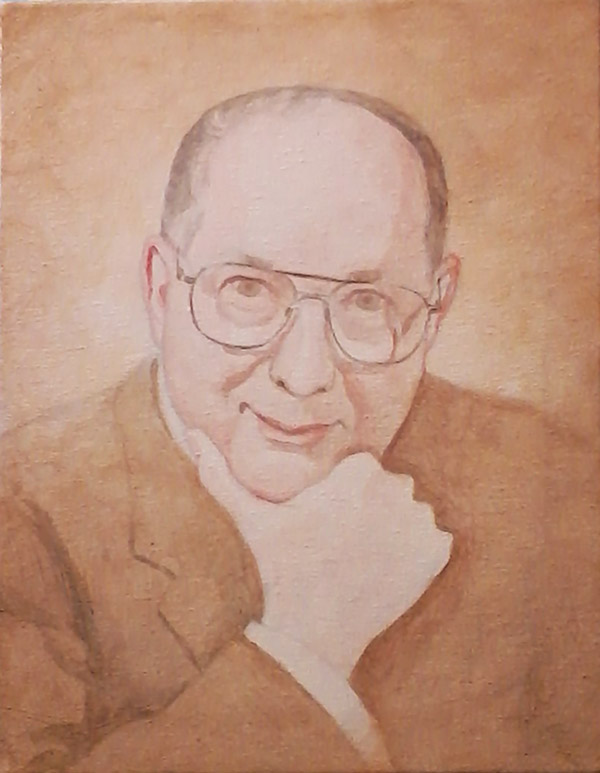
How to Paint Acrylic Portraits Step 2
Having correct value and color is vital. You can add nit-picking point-by-point detail to a painting all you want, but if you don’t establish correct value and color, it will only look amateurish.
Step 3: Keep on Adding Value As you add more and more glazes, the painting will begin to take shape. By glazing, you are adding a richness and depth that opaque color can’t achieve. In this stage, I am paying close attention to the color choice for the background. I am intentionally adding burnt sienna on the perimeter to give the background warmth, and lightening it to raw sienna and yellow ochre as I work toward the center. This draws your eye in towards the subject.
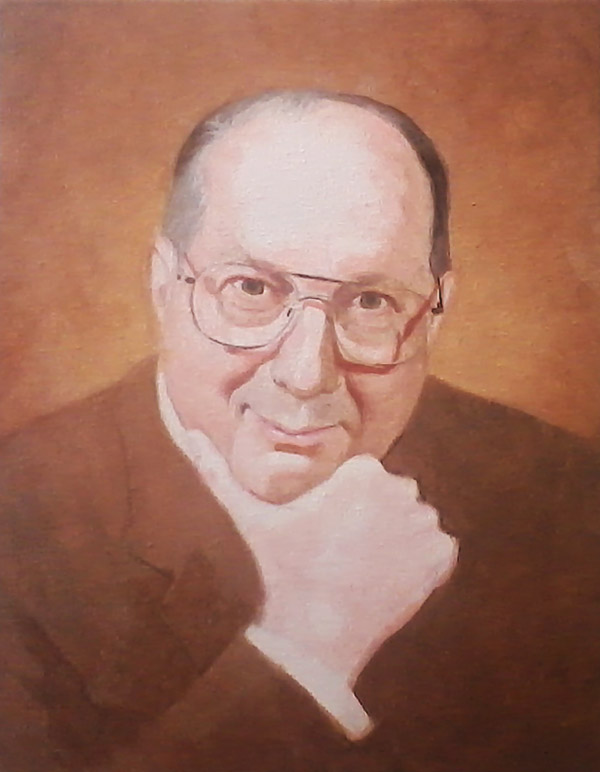
How to Paint Acrylic Portraits Step 3
In addition, I am carefully defining the features of the man’s face, by adding shadow to the nose, and especially under the glasses. The suit, by this time, has more than ten layers of glazes. Make sure you work your brush strokes in different directions as you glaze each time to smooth out the appearance of the paint layer. You can also use slightly different colors to add visual interest and vibrancy to the work. But what color choices should you use? Well, for a painting like this, that primarily has sepia tones, stay in that palette. But you will need to employ some cooler contrasting colors like blue and purple. Try to stay away from using black. It’s really a lifeless color. I establish black by using ultramarine blue, phthalo blue, and burnt umber in successive glazes. Here’s a good rule of thumb when mixing color, especially for portraits. I see so many artists that mix white into their colors in an attempt to achieve the lighter values of a portrait, but the end result is muddy. Flesh tones look sickly gray. Instead, do this: Use cool colors (blue, green and some browns) for darker areas and then use warmer colors (red, orange and yellow) for lighter areas. You will need to add red and orange into your flesh tones as you get into the lighter values, especially when you are painting a gradient–that is, a gradual shift from dark to light. Step 4: Clarify and Refine Your Painting. By this stage, you should have a really good idea of what your finished painting will look like. You’ve already established the majority of your values. The colors are mostly set. The painting should now look like a competent study created by a university art student. Now, it’s a matter of adding the nuances–those little details that really make the painting sizzle and beg to be looked at. Since in this example, I am painting a portrait on commission, and it is a memoriam painting of a lost loved one, it is more than making a painting that is visually compelling. The portrait must convey the likeness and personality of the man, because this will be a visual reminder to the grieving family of the person they loved so much. I received a card from one of the people in the bereaved family, and she said the painting made it like he was still there with her. To truly capture that “special something” in the subject, I believe, takes more than a trained eye and hand: it requires divine help. My habit is to pray before I start any work of art and before a studio session, especially when it’s a memoriam portrait. I pray that God will help me to capture the essence of the personality, and that it will truly bless and comfort the one who sees it. And He helps me. I believe you, too, will discover your painting process will go much smoother if you ask God for help. Now, at this level of completion, it’s time to add a simple yet extremely important detail: the reflection of light on the eyes. In most lighting situations, there will be a noticeable pinpoint reflection. Paintings made from outdoor portrait photography will often not have a bright reflection, but there still is a reflection of some sort.

How to Paint Acrylic Portraits Step 4
Capturing this reflection correctly is of utmost importance. You can get away with a lot minor mistakes in a portrait–you can paint the ears a little too big, or the chin a little too long, or the forehead a little too small, but if you get the eyes wrong, your entire portrait is wrong. Why? Because we are trained to look at each other’s eyes when we talk to each other. The eyes are the most striking feature on our face, and some say, the window to our souls. To make a face recognizable, you must capture the eyes as near perfect as possible. So pay careful attention to where you put the reflection, and whether or not there is just one reflection on the pupil, or two. One reflection will always be brighter than the other, but look for that secondary reflection and capture it. The iris (the colored part of the pupil) will always be darker on the side of the reflection, and lighter on the opposite side. It’s similar to a jewel.Remember, too that the shape and color of the eyebrows, as well as how close they are to the eyes are nearly as important as the eyes themselves in capturing the likeness. Pay close attention to what you see in your photograph and replicate it faithfully onto the canvas. You should have already taken care of this–mostly–in your sketch, but don’t worry, you can refine these details in the painting process if you were a bit off. At this level, I really began to concentrate on refining the glasses on the man’s face and painting some highlights on his lips, to give the illusion of moisture. Step 5: Finalize it and Bring it Home! This is the fun part of painting. It’s the paycheck for putting in several hours of preliminary work to get the painting to a point where it really starts looking good. You could call it done, and convince many people that it is done, but you want this art to really be your best work and to shine, so don’t quit yet.

How to Paint Acrylic Portraits Step 5 by Matt Philleo
There are just a few more nuances to capture, a few tweaks needed to make the artwork come alive. For example, in this portrait what I needed to do was give a little more attention to the man’s hand. So I glazed some blue-purple using ultramarine blue and a little alizarin crimson, toned down by burnt umber and white, to suggest veins underneath the skin. Then I strengthened the shadows along the right side of the hand, and lightened the knuckles with some white mixed with a bit of yellow. (Remember, you want to almost always brighten up the lighter areas with warm colors.)Finally, I added some strands of hair on his hands for that final touch of texture. If this had been a portrait of a lady, we would definitely keep that out! Here’s a tip for drawing or painting hair: Don’t paint every strand. Rather, block in the hair with color and value, and suggest the strands by adding just a few loose hairs here and there. If you over-detail the hair you actually lose realism.In painting a great portrait, you want to keep in mind that the face has a variety of hues. If you can capture these subtle differences, you will go a long way in convincing the viewer that they are looking at a photograph, or even better, an image of a real person. We know the lips are pink, and of course with lipstick, red. But the cheeks and ears are often more pink than the rest of the face, and sometimes the nose. The area right around the eyes is a little more of a bluish color (but just slightly!) And for a man, especially if he has darker hair, you can suggest the five-o-clock shadow by using a slightly bluish or green-bluish brown. This is especially true with the shadows under the chin. Again, don’t overdo it, or your subject will look like they only shave every other day! So when is the painting done? Well, some people say once you sign it, it’s done. I have often signed my work only to discover, a moment later, an unresolved area that needs desperately to be worked out and finished off. I can tell you this: for a commissioned painting, once you take a photo of it and your client approves it, you better leave it alone. They love it, and so, it’s done. Hands off! If the painting is for exhibition, or even if you are wondering whether or not it is done before you do a proof image, here’s a good way to tell: If your painting looks fantastic, and then as you continue to work on it, you are not adding any visual appeal to it, stop. You may end up even messing up what you already did. It’s done. And of course, a rapidly approaching deadline may tell you that your painting is done. That’s why I love to work in acrylic. With its fast drying time, I can literally finish a painting, proof it, get paid for it and ship it out all in the same day! Finished!

How to Paint Acrylic Portraits Final by Matt Philleo
Lastly, here is the final portrait in a much clearer image. This 11″ x 14″ painting took about 30 hours to create.
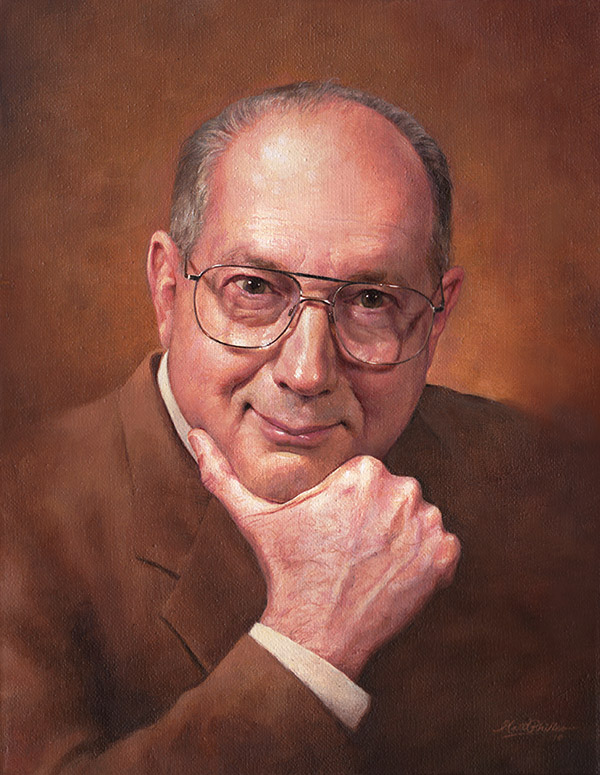
How to Paint Acrylic Portraits Final-clear by Matt Philleo
Oh, and just for fun, here are all the in progress shots of this painting, as a series. Now you can see the gradual shift in each stage of completion much easier.
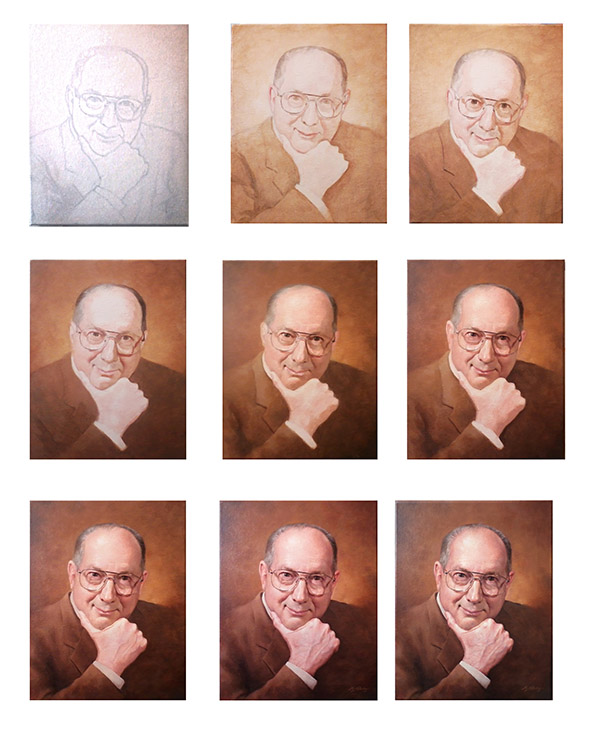
How to Paint an Acrylic Portrait In Progress
I hope these painting tips help you. Please let me know if you have any questions, or if I can help you with any painting project you may have! Share Your Thoughts! Please comment on this article and share with your friends using the social media links on the left sidebar or below. Thanks for spreading the word!

by Matt Philleo | Sep 15, 2015 | Christianity & Culture, Encouraging Thoughts, New Artwork
From the day we are old enough to crawl and grab for something, it’s obvious we have a constant desire for more. Our older brother has a toy and we want it, just because he has it. We grow up and go to the mall. Then we want the toy on Black Friday that everyone else is pushing and shoving to get.
Our neighbor has a new car. We were happy with our car a moment ago until we saw what she has. Now we want it. it is hard to be content today in this world. We have TV, newspaper, billboard and internet ads telling us we’re missing out and have a major problem unless we have the latest product they’re selling.
And when we buy something new, it captures our attention. We feel great with our new purchase, we can’t wait to try it out–or on–and then after a couple weeks or even less, the newness wears off. And off we go to something else that glitters and captures our interest once again. This cycle of discontent–acquiring–fascination–apathy–discontent continues on and on for our whole life, consuming everything good, ravaging relationships, until we look back in regret on the wreckage of our lives. By that time, it’s often far too late to do anything about it.
How can we be content?
All of us–unless we have major issues–want to better ourselves. We want to provide a decent living for ourselves and our family. We want to have something to share with others. We want to contribute value to our society. There is a struggle in working to provide those things. We see others who have succeeded and often feel jealous.
That’s the problem. It’s when we want what others have–that’s where we go astray. Instead, we should want what the God who created us wants us to have. He knows what is best for us. It may be that He wants us to be incredibly, coin-dropping wealthy. But He may also want us to be poor–at least if only for a season. And when I say poor–I’m not talking about being impoverished where you are homeless, starving, in danger of dying in the cold. I mean just living a clean, humble, hard-working, honorable life where perhaps your accommodations and possessions are less than what you’d like.
The Bible says, “Godliness with contentment is great gain.” We also learn from the Bible that we didn’t bring anything into this world and we definitely aren’t going take anything out of it either. So let’s be content with what we have, because God has promised to provide for us.
Maybe you’re thinking, “that sounds all well and good, but how can I be content when I live paycheck to paycheck and just barely get by?
Let’s put our lives into perspective.
If you live in America, as I do, even if you are dirt poor, you have a higher standard of living than over 90% of the world’s population. Consider this:
If you are homeless, there are shelters in nearly every major city.
If you have a home but struggle with putting food on the table, there are welfare programs and food pantries to help.
You have access to sanitary drinking water and have indoor plumbing where you can daily take a bath, wash your clothes, and remove your waste far from your home.
You have electricity to power a myriad of equipment, conveniently taking care of many household tasks that would have been the envy of the richest of us 100 years ago.
When it is steaming hot in the summertime, you have an air conditioning unit or at least a fan or two to cool off.
When it’s cold in the winter, you have heat and some sweaters or jackets to put on if it’s a little chilly.
You can get in your SUV and brave the roads, of course, after you neatly cleared off your driveway with a snowblower.
I don’t need to go into all the other gadgets we have to entertain and make our lives easier, such as laptops, smartphones, video game systems, etc. We have what we need for subsistence living and stuff on top of that to boot.
So here’s the deal. If we have food and clothing, we ought to be content with that.
Anything more than that is bonus. But still–why is it so hard to be content?
Being content starts on the inside. People can find something close to it when they get rid of their stuff and live a simpler, minimalized life. But true contentment only comes from the God who created us. When we believe in His word– the Bible–His peace that passes all understanding guards our hearts and minds (from the worries, cares, and competitiveness of this world) in Jesus Christ. First, we have a peace or contentment that comes from having a right relationship with God. That is accomplished through recognizing our sinfulness and trusting in the finished work of Jesus Christ (His death on the cross, burial, and resurrection) to make our consciences clean before God. Secondly, this contentment continues as we grow in our relationship with God and our perspective on life changes.
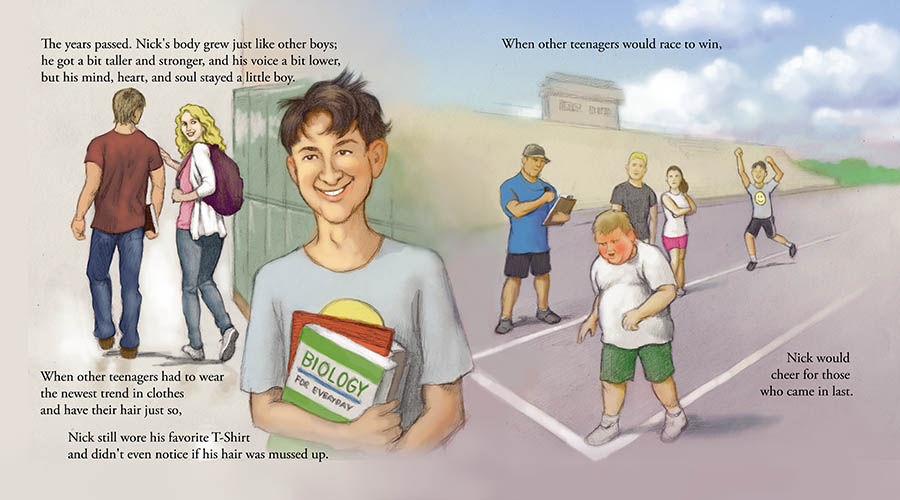
“The Boy in a Tree,” pages 11-12
To be content, you have to be happy being who you’re created to be, without comparing yourself to another.
This state of contentment comes from knowing God loves you, and He has everything you need within Himself to make you happy. Your world may be crumbling all around you. But you don’t bury your head in the sand and ignore reality. You instead reach out and into God, drawing strength from the fact that He loves you and won’t give you more than you can handle. You stand on the truth that He is more than capable to guide you through the storm and get you to safety. When you get a vision of the glory, the awesomeness of God, your problems dwindle in size by comparison. Now you’ve got the right perspective. Your problems may not have changed. But your attitude toward them has. This allows you then to come up with a better solution.
Oh, and guess what? Now when you get a hold of God, not only has your attitude towards your problem changed–He can work on your behalf. He often will do something amazing to help you out in your problems. I’m saying you will see something more than you doing something to get yourself out of a pickle, and humbly saying “God helped me.” You will actually witness a miracle apart from yourself that you can only attribute to God.
At other times, in the sovereignty of God, you may remain in a difficult situation for months or even years. That’s okay. As hard as that situation is, when you feast on the goodness of God, that trial seems like an annoying mosquito you can swat away. Your trust in God grows accordingly, and that in itself is a blessing.
Here are a few more pages of the children’s book by Pam Boodle I illustrated, “The Boy in a Tree.” Nick, a child cognitive disabilities, is a boy who grows up yet his mind remains as a young child’s. In many ways, this is his greatest asset. Being content comes naturally to him.
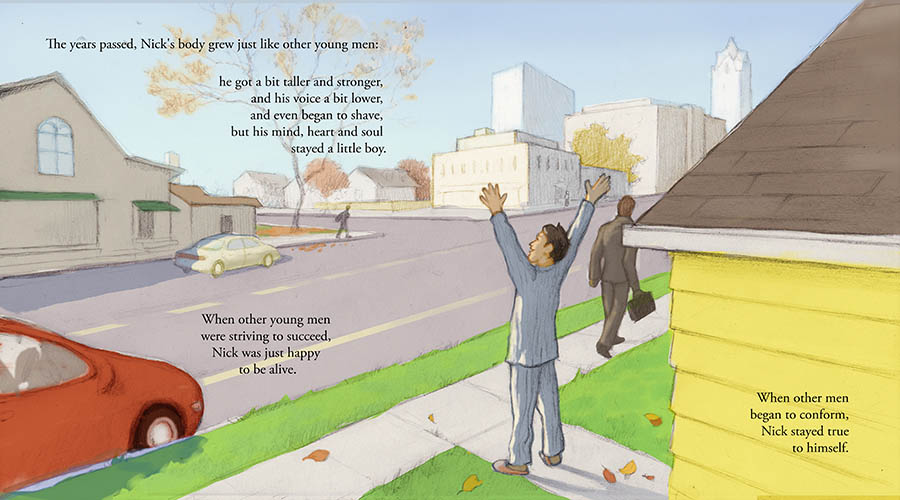
“The Boy in a Tree,” pages 17-18.
You can stir up a spirit of contentment by choosing to be thankful. Sometimes thanksgiving will rise up within you like bubbles to the top of champagne when you receive an unexpected blessing, but most of the time you have to actually take stock of all the good things you have and thank God for them. If you remember that old hymn “Count your blessings, name them one by one…”
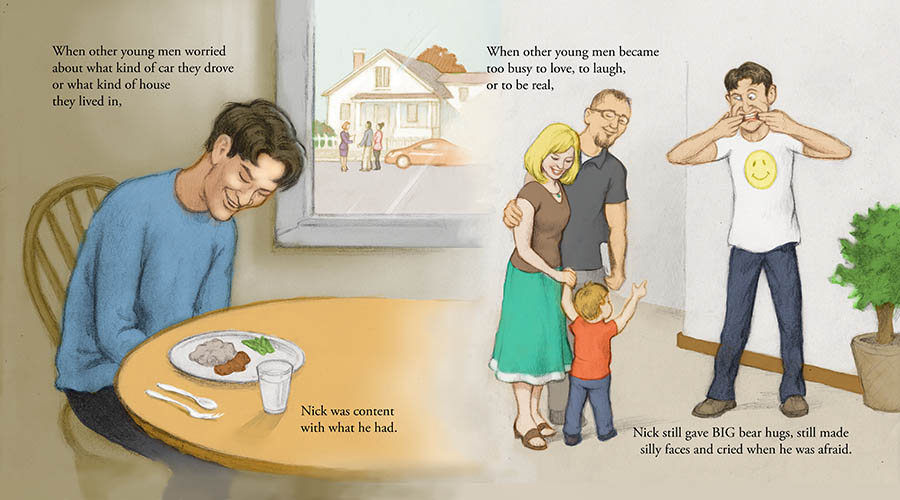
“The Boy in a Tree,” pages 19-20.
I have a habit of praying for my food, but I have to admit, a lot of times it becomes a lifeless ritual. I’m not actually thinking about how good God has been to me when I mumble the words. I just want to dig into that juicy burger! But sometimes, I’ve just dropped to my knees (when I was eating alone) and realized how blessed I am to eat the kind of food I have access to when others in the world have gone days without anything.
A life lived in contentment is a life without regret.
If we are content, we will pursue the right things–relationships for the benefit of helping others. If we are discontent, we will pursue the wrong things–relationships for the benefit of acquiring things: money, possessions, power, and fame. We are so blessed in this nation, even now, with a shaky economy. Let’s stop and give God thanks for all He has done for us. Let’s be happy being us, and watch God make us better as we live in a spirit of contentment.
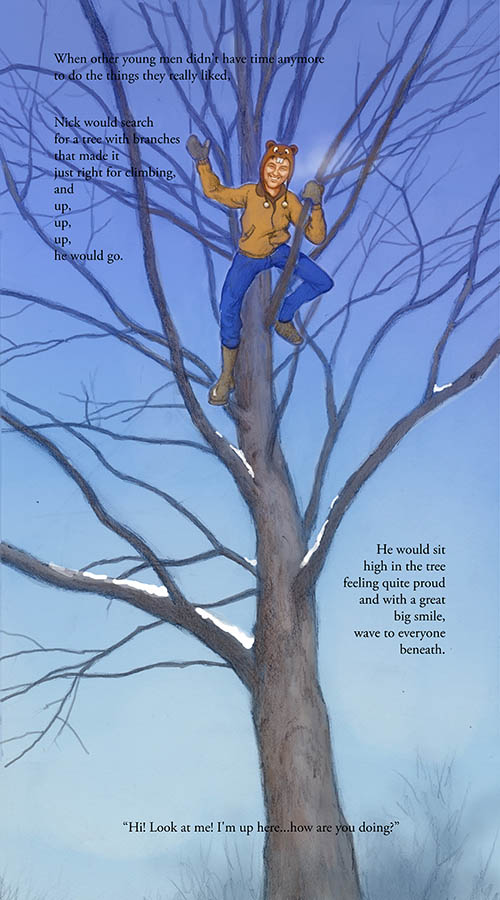
“The Boy in a Tree” pages 21-22.
Share Your Thoughts!
I’d love to hear your comments, questions, thoughts, and ideas. I will personally respond to any comments you leave. If you like this post, please share it with a friend by using the social media links on the left sidebar. Thank you!

by Matt Philleo | Sep 10, 2015 | Christianity & Culture, Encouraging Thoughts
The recent malaise in Rowan County, Kentucky with the defiant County clerk Kim Davis is a signpost signaling a new era in the culture of America. Biblical, traditional family values are out; unorthodox, non-traditional values are the new normal.
I’ve been following the news on Kim Davis very closely. (Maybe a little too closely!) If you aren’t aware by now, she is the Kentucky county clerk who dared to defy the recent ruling by the Supreme Court legalizing same-sex marriage, and then was jailed for it. She has put a name and a face to the incendiary cultural clash of traditional Judeo-Christian values and post-modern secular atheism. Never before in America has a government worker been jailed for simply following their Christian belief.
After the Court’s ruling in June, I felt like I was watching a football game and my team lost. And when Kim Davis was jailed, that was the dagger! But now, she has been released and it remains to be seen if she will continue in her courageous rejection of an unjust law (which is really no law at all).
I and many Christians around the nation prayed for her to be set free, and that she would strand strong in the face of severe opposition. I’m glad she didn’t give in to the pressure to conform. Somehow though, her release from jail seems like a hollow victory, especially with the strict warnings the judge imposed on her to no longer interfere with the signing of certificates. It feels like we just scored a touchdown, but we’re down 41-10 with 2:00 minutes remaining in the game.
The whole Kim Davis scenario has set a precedent of what will happen if anyone dares to oppose this new intolerant regime by standing up for traditional marriage. And not only the government is caustic towards people like Kim Davis, but if you look at the comments after the news articles and tirades in social media you get the idea that a good majority of Americans would hang her if they could.
In the wake of all of this, many Christians wonder, how should we then live?
Of course, we’ve been hurtling down this path for quite some time now. It has not been a seismic shift. Instead, it has been a gradual decline in morality. But for those of us who hold fast to what the Bible teaches and are old enough to remember an America that upheld traditional common-sense definitions of what constitutes marriage and family, this incident is like a mile-marker delineating how far we have come. How far we have gone off-track. This story burns in our mind as a daunting image of the New Anti-Christian America.
Since America is now clearly opposed to Biblical Christianity, how then shall Christians live? I see four options:
1. If we can’t beat ’em, join ’em.
We can begin to agree with the increasingly immoral culture and accommodate our Christian beliefs to the rapidly changing social norms around us.
We can interpret the Bible according to 21st century American society and make it more relevant to our hearers. After all, we want to be able to fit in enough to share Jesus with those around us, don’t we? Jesus didn’t get mad at anyone or judge anyone, did He?
When we actually read our Bibles, we discover a Jesus who was indignant at sin, although He showed amazing mercy to those trapped in it.
I am amazed at how many Christians (perhaps self-professing) defend the homosexual lifestyle and equate their demand for rights with the civil rights movement of Martin Luther King, Jr. However, homosexuality is a behavior, not an inherent characteristic such as skin color or gender. While homosexuals are often vilified, treated by many Christians as if they were the only sinners worthy of judgment, the behavior is still a sin, because it is a perversion of God’s original design for men and women. But it is also a sin that can be forgiven and a behavior that can be changed by the grace of God.
2. If we can’t join ’em, beat ’em.
We can become militant ourselves, waging a counter-offensive in the culture war and demand that America returns to its Judeo-Christian cultural roots by aggressive political efforts, picketing, petitions, lobbying, calling representatives, even preparing militarily to fight against a possible government subjugation of its citizens. Now I am not saying that we shouldn’t vote or contact our representatives. We are fortunate enough to live in a Constitutional Republic, where we have many rights that are still the envy of the world. With those rights come the responsibility to be involved in the political process of electing leaders that most closely represent our values. However, we are do not wage war as the world does. As the Bible says, our weapons are spiritual.

“Victory in Surrender” 16 x 20, acrylic on canvas, by Matt Philleo.
I don’t think fighting the culture war politically is the way to go.
3. If we can’t join ’em or beat ’em, forget ’em.
We can bury our head in the sand and believe things are not that bad, or will get better with time.
Maybe if we get a Republican president, things will turn around. Not a chance. Remember Roe vs. Wade? Over 40 years later, all we have managed to do–even with several Republican administrations–is enact a few slight restrictions on abortion. But for the most part, that industry is going full steam ahead. We’ve gotten a few hits, but we have definitely not tackled the issue.
4. If we can’t beat ’em, join ’em, or forget ’em, we can…help them!
We can do what Paul the Apostle did: reach out to others in a wicked and pagan culture with the pure, unadulterated, transformative message of the Gospel, one person at a time.
We are not trying to save the culture.
The culture in America is clearly pagan.
President Obama was right: this is not a Christian nation.
In fact, it never was. Rather, in its inception, it was a secular nation that highly esteemed a Judeo-Christian worldview, and accordingly, governmental laws and policies reflected that. But now, America’s worldview, at large, is no longer Christian. That is why the laws and policies passed no longer favor Christians, but instead threaten us. It is easy then, to become reactionary and want to steer our culture back to its godly heritage. It would be good if this happens, but only if indirectly, as a byproduct of reaching people with the good news of Jesus Christ.
Many postmodernists, especially generation Xers and millenials, believe fundamentalist Christians want to take over the government and I don’t think they are completely off the mark in feeling that way. However, Jesus said: “My Kingdom is not of this world.” Our goal should not be to establish a theocracy.
Instead, let’s aspire to do what Paul did. He preached the gospel and people got saved. How many? Probably a relatively small percentage of the Western world’s population. But the fact is, souls were saved. In the same way, Peter the Apostle urged his fellow Jewish countrymen, “Be saved out of this wicked and perverse generation.” Recently, the associate pastor at my church wisely remarked in one of his sermons that “we should not curse the darkness but rather light a candle in it.” I wholeheartedly agree. And the darker the darkness, the brighter the light shines by contrast. The thrust of our efforts should not be trying to save the culture, but to save people out of the culture.
So, do we stand up for the traditional view of marriage? Yes, absolutely! The best way we can do that as Christians is to live in such a way that we are above reproach. In other words, we want the world to see that we are different, and the difference maker is Jesus. Our marriages and families should be rock solid, a visible testimony of the solid Rock, our Lord Jesus Christ. Then when we speak to others about Christ, we will actually have something to say, not just the usual Christian rhetoric that only confirms the world’s perception of us as hypocrites.
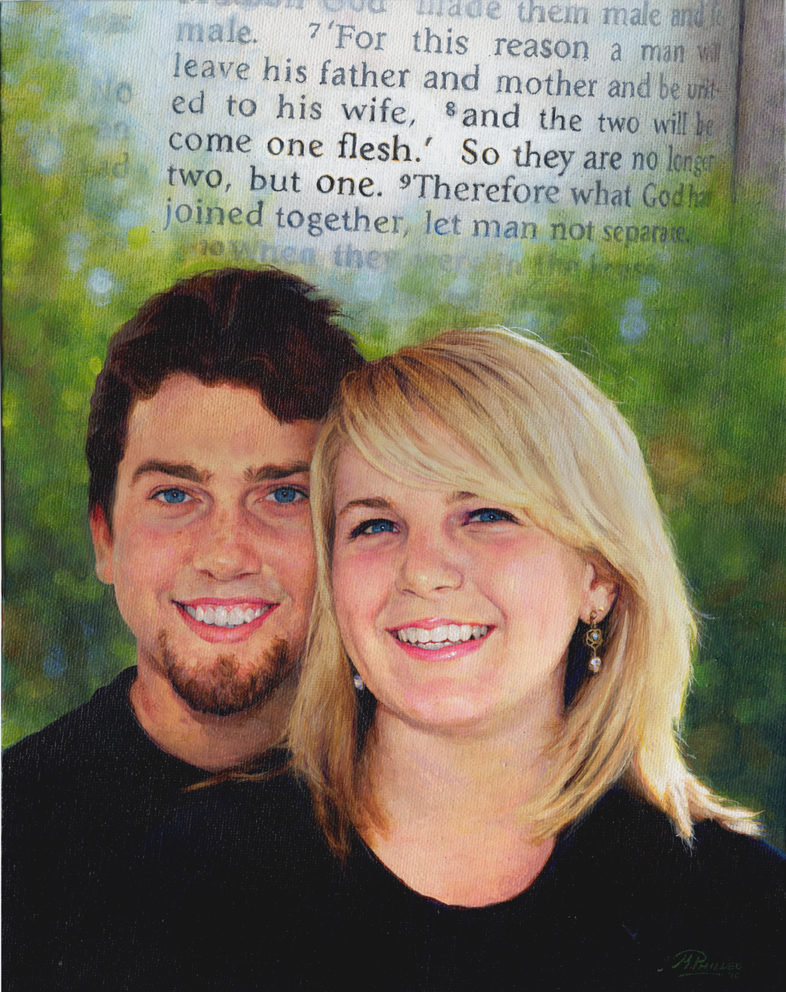
Ben and Amber Portrait 11 x 14, acrylic on canvas
Should we give up on the idea of America turning around? No, of course not! This is a nation of people. And people can repent and turn to God. So if Christians got serious about their faith, repented of their sins and many unbelievers were born again, certainly we’d have a revival on our hands. It has happened before in our nation’s history in the late 1700’s and it could happen again. In fact, we should be praying that it will. God does not want anyone to perish, but wants all to repent.
The illustration shown at the top of the post is a painting I did for a baby gate manufacturer. They wanted an illustration that shows a happy family from 1950’s era. The beaming young parents joyfully watch their baby playing on the carpet in front of them, the perfect image of domestic happiness. While I understand that there may be more myth than reality to this “Leave it to Beaver” and “Father Knows Best” generation, there certainly was a more positive view of the traditional family during that time. A family consisting of two loving parents, husband and wife, is no longer the norm. Broken homes, fractured marriages, and strange relationships now called marriages is the new reality.
This culture war will not be won with clenched fists, loud mouths, and fast feet. It will be won with open hands, listening ears, and bent knees. Let us serve others with our hands, so everyone will see the love of Christ in us. Let us listen to others’ stories, truly care about them so that we can share the gospel with a receptive heart. And most importantly, let us pray that God would be glorified by what we say and do as He uses us to rescue lost and dying people out of a wicked culture.
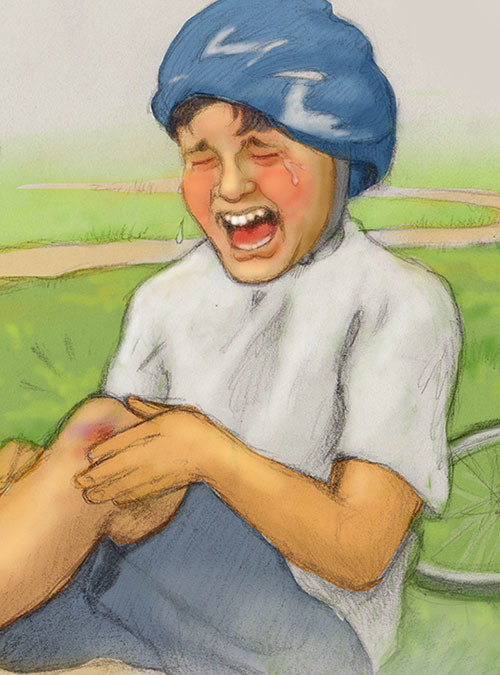
by Matt Philleo | Aug 29, 2015 | Christianity & Culture, Encouraging Thoughts, New Artwork, Personal Inspiring Stories
“Quit your crying!”
From the time we were little children, most of our parents told us not to cry when we were hurt. Even if our moms and dads were of the more nurturing nature, the message that is crying is for wimps was reinforced by our classmates, heroes on TV, and society’s expectation in general.
Of course, there is a time to stop crying, deal with your problem and move on, just as my wife and I tell our children.
But how many of us are holding back tears during a time when we should let them flow? We may experience an extreme trial such as a job loss, the severing of a close relationship, abuse toward us or those we love, accidents, bad news of a serious illness, or even a death–and because we were taught to hold back the tears, buck up, and save face–we stuff the feelings of grief and emotional trauma deep down where we think it’s hidden for good.
But it has a way of coming back.
In anger, frustration, bitterness, despondency–we often lash out toward those who are closest to us and could console us.
We hide behind a wall, a veneer of togetherness, when inside we are falling apart.
In this post, I am showing pages 7-10 of the children’s book I recently illustrated, “The Boy in a Tree,” by Pamela Boodle. (If you missed my first post introducing this book, you can check it out right here.)
In the book, Nick, a cognitively impaired child, sees the world in a different way than most of us. Although he may not be able to do many of the things we take for granted… …His slower pace naturally allows him to notice the more important things in life that really matter.
And because he is not socially adept enough to hide behind a facade of respectability, he goes around living life by…just being himself. He doesn’t care how he looks to others. When he’s happy, he’s not too “cool” to show it. When he’s hurt, he doesn’t hold back the tears. And because of this, he is more emotionally healthy than many “typical” people.
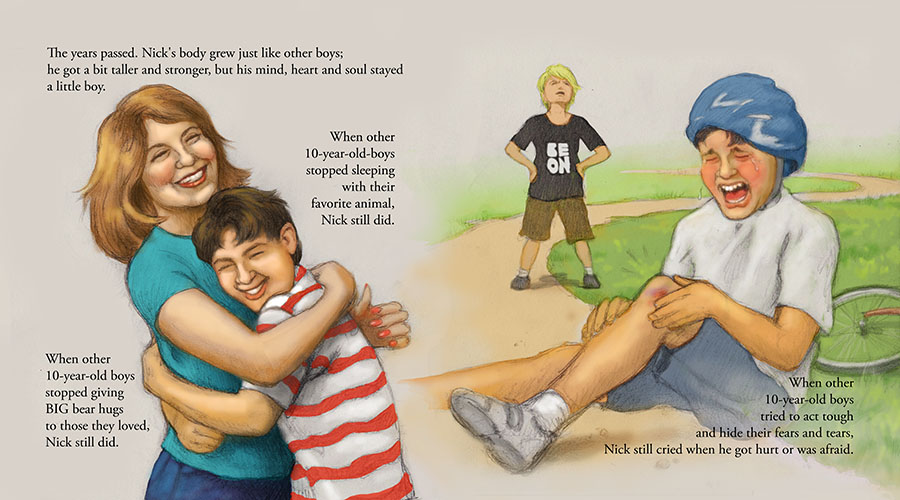
“The Boy in a Tree,” pages 7 & 8

“The Boy in a Tree,” pages 9 & 10
My dad died from brain cancer in 2010 at the age of 64. He and my mother divorced 11 years prior to that and I hadn’t been very close to him up until that point, especially since he moved to another state. But after learning of the tumor, my family and I visited him several times.
We saw the progression of the disease and how it reduced him from a confident, articulate, intellectual man to a blind, nearly helpless child, who needed assistance going to the bathroom. Unlike many people who are suffering from cancer, he was not bitter or despondent. He was very thankful whenever anybody did anything for him. All he wanted to do at the end was snuggle with his children. So, putting pride and awkwardness aside, I snuggled up next to my dad, and after a while he began to rub my belly. This seemed strange at first, but then I thought that this was maybe what he might have done when I was a young boy, and that somehow this might have brought him comfort, a feeling of closeness to his son.
I cried.
I prayed for him that God would heal him. I wanted him to stay alive so he could see and hold his grandchildren, and watch them grow up.
But about a month later, he died. When I got the news on the phone from his wife (who took care of him so selflessly, by the way) I didn’t feel anything. I expected to feel grief and wondered if something was wrong with me. Then I remembered how I cried so deeply during our last visit and, although I didn’t know it at the time, I realized I already grieved his death. I didn’t feel remorse. I was glad we drew close at the end and had no regrets.
About a year later, an older man in our church died. He was the head usher, a kind and gentle man that everybody seemed to love. At his funeral I grieved his death with many tears. Although I knew he was in heaven with the Lord, I missed his fellowship.
In Christian circles, we often chide people for grieving at a funeral.
Because we have such a great hope of seeing our departed loved ones in heaven, we religiously expect a stoic response–hypocritically renamed as “joy”–during a time when we should be the most vulnerable and open with our feelings.
But in the Bible, you will see a completely different response.
For example, when Lazarus died, what did Jesus do? He wept. (John 11:35) When Stephen, the first martyr of the Christian church died, what did people do? “Godly men buried Stephen and mourned deeply for him.” (Acts 8:2) When Tabitha died, what did the Christian church do? Did they say, “Hallelujah, Tabby’s risen to glory!” No! “All the widows stood around him (Peter), crying and showing him the robes and other clothing that Dorcas (Tabitha) had made while she was still with them.” (Acts 9:39)
Do you remember Samuel? Even if you don’t know the Bible very well, the name is so well known today because of a famous Jewish prophet who lived 3,000 years ago. I don’t think it is stretching the truth to say that there would be no Samuel unless a woman wasn’t afraid to cry. His mother, Hannah, couldn’t have any children. And in the Jewish culture, a woman being unable to have a child was the worst possible shame to endure. So what did Hannah do?
She cried out to God. Literally.
In the first book of Samuel, we read in verses 10-11:
“In her deep anguish Hannah prayed to the Lord, weeping bitterly. And she made a vow, saying, “Lord Almighty, if you will only look on your servant’s misery and remember me, and not forget your servant but give her a son, then I will give him to the Lord for all the days of his life…”
And then in verse 20, it tells us God answered her prayer.
“So in the course of time Hannah became pregnant and gave birth to a son. She named him Samuel, saying, “Because I asked the Lord for him.” Samuel turned out to be a God-following man, the prophet who would anoint King Saul and King David, one of Israel’s greatest prophets of all time. But his life came as a result of a broken person who wasn’t afraid to show her brokenness.
Hannah didn’t pretend to be happy or, on the flip side, resign herself to misery. She owned her pain, and cried out for relief.
And that’s exactly what she got.
When we grieve, it’s like showing our wound to someone who can help us, instead of letting it fester and get infected. If we are real with God, others, and ourself, and say “This is my pain, I’m not hiding it. God please help me through this! Deliver me!” Our loving Lord will come and salve our wound, and healing will come. In time, we will experience true joy–not a forced smile that looks like Joker’s face–but a true, abiding, pervasive joy that comes straight from God, settles down into the deepest part of our being, and then bubbles up and flows out of us like a fresh spring of water!
QUESTIONS TO PONDER:
1. Is there any pain from the past that you have hidden and could deal with now?
2. How can you show compassion to someone who is hurting and help ease their pain?
3. Do you know what it is like to feel true joy in during incredible sorrow or difficulties?
Share your thoughts!
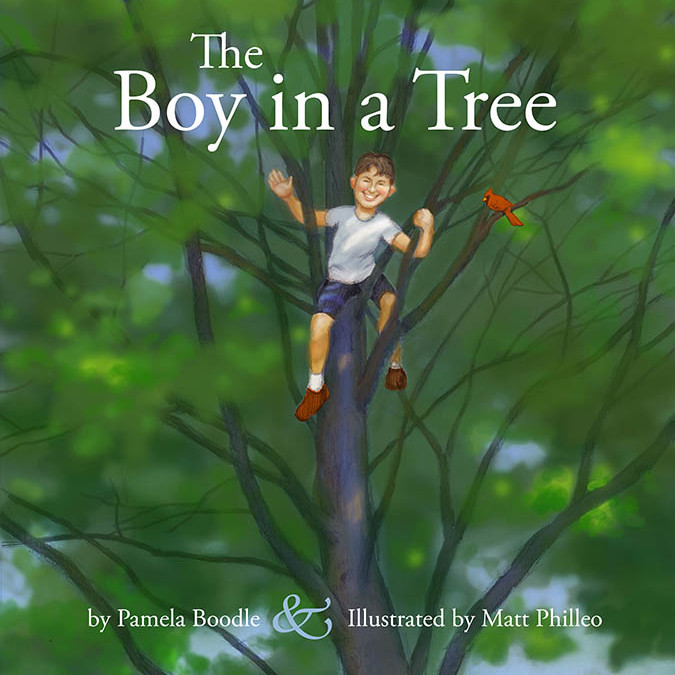
by Matt Philleo | Aug 21, 2015 | Encouraging Thoughts, New Artwork
Do you have a child with special needs or know someone who does? These days, it’s getting more and more common to see children with special needs anywhere you go. I speak from personal experience–my son is one of these wonderful children. They have a different way of looking at the world that can really help you to see life from a whole new perspective. If you’re close enough to them, you will learn things about yourself (especially your own shortcomings) that you never knew, and you will grow as a person just by being with and relating to them.Almost a year ago, I was asked to illustrate a children’s book called the “The Boy in a Tree,” written by my sister’s friend, Pamela Boodle. This book follows the life of a cognitively impaired child who has a fascination and relentless interest in climbing trees. And not just any tree. He searches for trees “with branches made just right for climbing and up, up, up he goes.” Over and above the grand height he ascends to in those towering limbs, his childlike outlook on life encourages us to take pleasure in the simple joys of life. During the last several months between other commissions, I worked on the illustrations for this book, starting with a freehand pencil sketch for the layouts, scanning the drawings into my computer, and then coloring them with Photoshop’s paint tools. This allowed me to keep the texture of the pencil and that hand-drawn look while having the flexibility to quickly change color and prepare a digital product ready to be printed.I met with the author today at a local coffee shop and showed her the illustrations I did for the book. While we were there, a family with two young children gazed intently at the color copies of the book illustrations. That’s a good sign! The parents said, “I think you have an audience already.”
It is my hope as the illustrator of this book, and certainly even more so the author’s…
…that the words and images will help children to see the people around them who may be different than them in a new light, and think about life’s purpose, what’s truly important, and what we are really here for. I think adults will get something out of it too. I know the author’s words really touched me as I read them, and that’s part of the reason why I agreed to do the illustrations for the text.Here are the first several pages of this 28 page picture book. It is not published yet, but if you have any interest in this book, please let me know and I will put you on a list so that when it does become available, you can be one of the first to get a copy!

“The Boy in a Tree” Intro Page 1

“The Boy in a Tree,” Intro Page 2
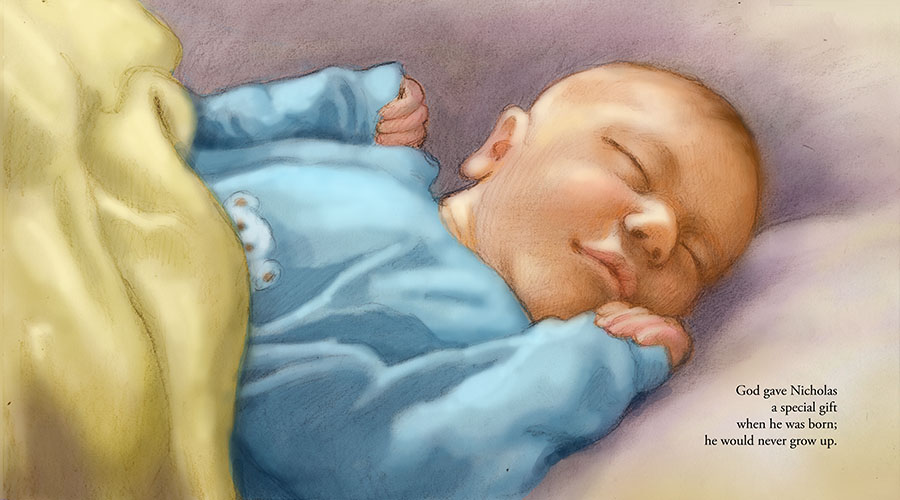
“The Boy in a Tree,” Page 1 & 2
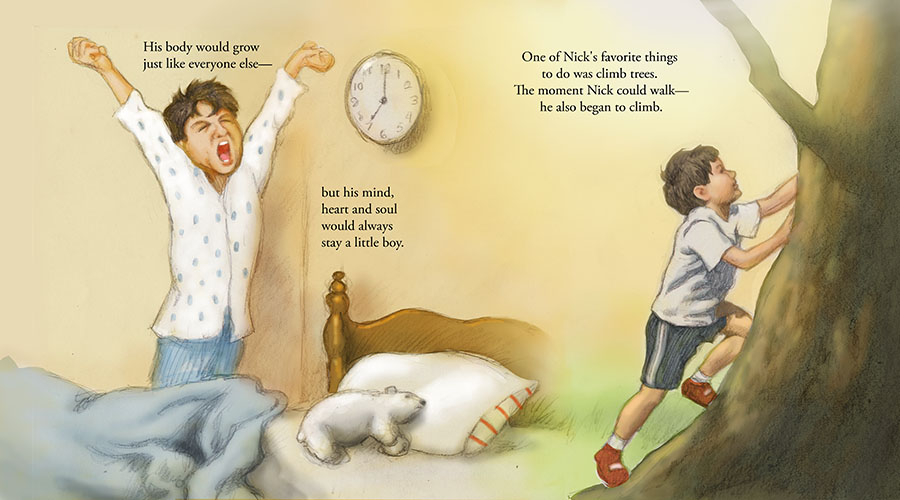
“The Boy in a Tree,” page 3 & 4
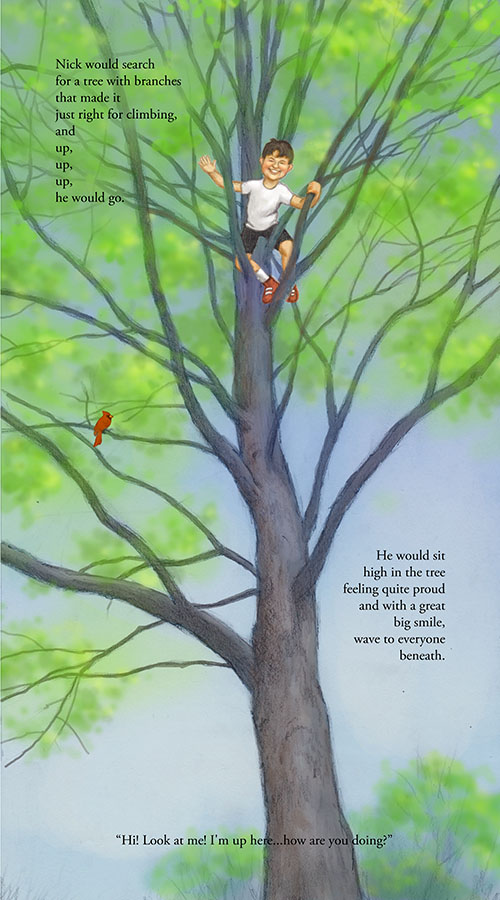
“The Boy in a Tree,” Page 5 & 6
That’s it for now. I will be including some more pages of the book in a future post, but the entire book will be available only in print. I hope these words and images have encouraged you today!
QUESTIONS TO PONDER:
1. How do people with special needs add value to our society?2. What specific things can you do to encourage a person with special needs?3. How can you, in a practical way, help or encourage a person who is caring for someone with special needs?





























Recent Comments